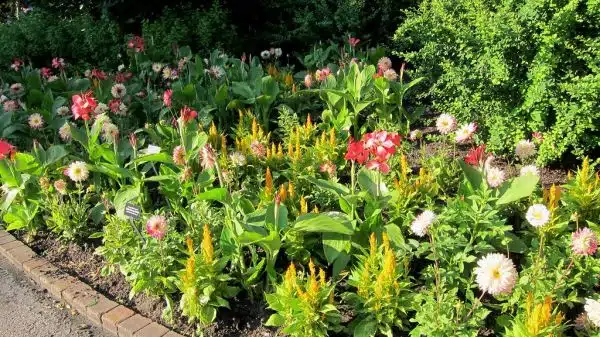Canna bulbs are a popular choice for gardeners due to their beautiful flowers and lush foliage. However, as winter approaches, it becomes necessary to protect these plants from the cold weather. One effective method to ensure the survival of canna bulbs is to dig them up and store them for the winter season.
To successfully dig up and store canna bulbs, it is important to follow a few key steps. This process involves carefully removing the bulbs from the soil, cleaning them properly, storing them in a cool and dry place, and monitoring them regularly throughout the winter months. With proper care and attention, canna bulbs can be successfully stored for months and replanted in the spring for continued beauty in your garden. In this article, we will provide detailed instructions on how to dig up and store canna bulbs for winter.
Preparing Your Garden For Winter
Winter is coming, and it’s time to prepare your garden for the harsh weather conditions. Covering plants is one of the most crucial steps in protecting them from frost or snow that may damage their delicate leaves and branches. You can use a variety of materials to cover your plants, such as burlap sacks, blankets, or plastic sheets. Make sure to tie them securely around the base of the plant to prevent wind from blowing them away.
Another important aspect of winter gardening is watering. Many people assume that plants don’t need water during this season because the ground is frozen. However, this is a common misconception. The truth is that plants still require moisture to survive, especially during extended dry spells. Therefore, it’s essential to water your plants regularly throughout the winter months.
Now that you’ve covered your plants and ensured they have enough water to survive the winter months, it’s time to turn your attention towards digging up and storing your canna bulbs. But before we get into that process, let’s first identify when it’s time to dig up these bulbs for safekeeping during winter.
Identifying When To Dig Up Your Canna Bulbs
Canna bulbs are a perennial plant and can survive the winter underground if they are properly cared for. Knowing when to dig up your canna bulbs is crucial in ensuring their survival. Signs of maturity should be looked out for before digging up your canna bulbs. When the flowers on the plant have bloomed and started to wither, it’s an indication that the bulbs have matured and are ready to be harvested.
Caring for canna bulbs requires precise timing as leaving them in the ground too long may damage them, while digging them up too early may hinder their blooming potential. The best time to dig up your canna bulbs is after the first frost or when temperatures drop below 50°F. By then, the foliage would have died back completely, indicating that it’s time to harvest your canna bulbs.
To ensure that you don’t miss this vital stage in caring for your canna bulbs, here are some additional signs you should look out for:
- The leaves of the plant will start to yellow and droop.
- The stems will begin to turn brown.
- You’ll notice a decrease in flower production.
By monitoring these signs closely, you’ll be able to harvest your canna bulbs at their prime state and prepare them accordingly for storage through winter.
Gathering Necessary Tools And Supplies
Now that you know when to dig up your canna bulbs, it’s time to gather the necessary tools and supplies for the job. Did you know that using the right tools can make a significant difference in the success of your bulb storage? According to a recent study, gardeners who used specialized tools were able to store canna bulbs longer and with fewer losses than those who did not.
Tool selection is critical when digging up canna bulbs. You will need a shovel or fork with sharp edges, which will allow you to loosen the soil around the bulbs without damaging them. A pair of gloves will also come in handy since digging in dirt can be rough on your hands. Additionally, consider getting a bucket or container to place the bulbs in as you dig them up.
Supply management is equally important when it comes to storing your canna bulbs. Make sure you have enough peat moss or vermiculite to cover each bulb completely. These materials help maintain moisture levels and prevent rotting during storage. You may also want to label each container with the date and variety of bulb inside so that you can keep track of them easily. With proper tool selection and supply management, you’ll be well on your way to successfully storing your canna bulbs for winter.
As you prepare for bulb storage, don’t forget about clearing the area around your canna plants. This step is crucial because any remaining debris could attract pests or disease that could harm your plants next season. Be sure to remove any dead leaves or stems from around the plant’s base and rake away any excess debris from nearby areas. Once finished, you’ll have a clean slate ready for planting new bulbs come springtime.
Clearing The Area Around Your Canna Plants
Weeding is an important first step in clearing the area around canna plants, as it helps to promote air flow and reduce competition from other plants. Pruning can also help to maintain the desired shape of the canna plants, and should be done carefully to avoid damaging the plants. Mulching can be a beneficial addition to the area, as it helps to retain moisture and provide insulation for the winter months. Placing a layer of mulch around the canna plants will also help to reduce weeds and maintain soil temperature. Additionally, if the canna plants are to be stored for the winter, they should be dug up carefully and stored in a cool, dry location. If necessary, the canna bulbs can be divided during this process to propagate new plants.
Weeding
Weeding is an essential step in clearing the area around your canna plants. As a horticulturist or garden specialist, it is important to understand that weeds compete with your plants for nutrients, water, and sunlight. Therefore, it is crucial to remove these unwanted plants to ensure the healthy growth of your cannas.
Companion planting can be an effective method of natural weed control. By planting certain herbs or flowers alongside your cannas, you can deter weeds from growing. For example, marigolds are known to repel nematodes and other harmful pests while also suppressing weed growth. Additionally, planting mint near your cannas can help prevent weed growth due to its strong scent.
It is also important to manually remove weeds on a regular basis. This includes pulling out weeds by hand or using a hoe to cut them at their base. Be sure not to disturb the roots of your cannas while weeding and avoid using chemical herbicides as they may harm both your plants and the environment. With proper weeding techniques and natural weed control methods such as companion planting, you can ensure that your canna plants thrive in a healthy environment free from competing weeds.
Pruning
Clearing the area around your canna plants is a crucial step in maintaining healthy and thriving greenery. In addition to weeding, pruning is another technique that garden specialists use to keep their gardens and landscapes tidy. Proper pruning techniques are essential for promoting healthy growth, improving the appearance of your plants, and preventing the spread of diseases.
Pruning involves selectively removing dead or damaged stems, leaves, or flowers from your cannas. Winter pruning tips include cutting back any dead or diseased foliage before spring arrives. This ensures that the plant has ample energy reserves to produce new growth once the weather warms up. Pruning also promotes air circulation around your plants, which reduces the risk of fungal infections and other diseases.
When pruning your cannas, it is important to use clean and sharp tools to avoid damaging healthy parts of the plant. You should also avoid over-pruning as this may weaken your plant’s structure and make it more susceptible to pests and diseases. By following these simple winter pruning tips and maintaining proper pruning techniques, you can help ensure that your canna plants remain healthy, vibrant, and beautiful throughout the year.
Mulching
Clearing the area around your canna plants is an essential task for maintaining their health and beauty. Aside from pruning, mulching is another technique that garden specialists use to keep their gardens and landscapes tidy. Mulching involves covering the soil around your canna bulbs with a layer of organic or inorganic material. This layer helps retain moisture, suppress weed growth, regulate soil temperature, and enhance soil fertility.
Mulching offers several benefits to your canna plants. One of its main advantages is that it keeps the soil moist, which is crucial for the growth and survival of your bulbs during dry weather conditions. Mulch also helps suppress weed growth by blocking sunlight from reaching weed seeds, reducing competition for nutrients and water with your canna bulbs. In addition, mulching regulates soil temperature by insulating the soil during winter months and keeping it cooler during hot summer months.
When choosing mulch materials for your canna bulbs, there are several options available. Organic materials such as bark chips, straw hay, or shredded leaves are excellent choices as they decompose gradually over time adding organic matter to your soil. However, they may attract pests or harbor diseases if not properly treated before application. Inorganic materials such as gravel stones or rubber mulch are durable options that don’t break down but don’t add any nutrients to your soil either. Whatever material you choose, ensure that it’s applied at a depth of 2-3 inches around your plants’ bases while avoiding direct contact with stems or foliage.
In conclusion, mulching is another crucial technique in maintaining healthy canna plants alongside clearing and pruning practices. It offers various benefits such as retaining moisture in the soil, suppressing weed growth while regulating soil temperature and enhancing its fertility ultimately contributing to healthy plant growth throughout the year. When selecting mulch materials for your cannas, consider organic versus inorganic options while ensuring proper application techniques so that you may reap all its benefits successfully.
Loosening The Soil Around Your Canna Bulbs
Before digging up your canna bulbs for winter storage, it is essential to loosen the soil around them. This process allows for better aeration of the soil, which promotes root health and helps prevent rot. Start by using a garden fork to dig around the perimeter of each plant. Then, gently rock the fork back and forth to loosen the soil without damaging the bulbs.
Loosening the soil around your canna bulbs not only promotes root health but also aids in garden maintenance. It makes it easier to remove any weeds or debris that may have accumulated near the base of each plant. This step will help keep your garden tidy and free from harmful pests and diseases that could affect bulb preservation.
To ensure successful bulb preservation, follow these four tips:
- Do not remove any foliage until it has turned brown and withered away naturally.
- Cut back any remaining stems to about 6 inches above ground level.
- After loosening the soil, carefully lift each bulb out of the ground using a garden fork or shovel.
- Store bulbs in a cool, dry location where they will not freeze or be exposed to moisture.
As you prepare to move on to carefully removing the canna bulbs from the ground, remember that proper soil aeration is essential for maintaining healthy roots and preserving your bulbs over winter months. Follow these tips for successful storage and enjoy beautiful blooms year after year!
Carefully Removing The Canna Bulbs From The Ground
According to a recent study, canna bulbs are best harvested before the first frost of the season. This ensures that the bulbs are still healthy and free from damage caused by cold weather. Safe handling is essential when removing the canna bulbs from the ground. The key is to dig around the plant, ensuring that you avoid damaging the delicate roots while at it.
Proper storage is critical in preserving canna bulbs for winter use. After carefully digging up the bulbs, shake off any excess soil before placing them in a warm and dry location for several days. Once they have dried sufficiently, store them in a cool and dark place where temperatures range between 45-50°F. This helps prevent premature sprouting during storage while ensuring that they remain healthy for planting again.
Avoiding damage and maximizing yield are essential practices when digging up canna bulbs. Use a fork or spade to loosen up the soil around the bulb gently. Avoid pulling on leaves or stems as this may cause breakage resulting in lower yields come springtime. Take care not to cut into the bulb as this will lead to rotting and spoilage during storage. Following these guidelines ensures maximum returns on your investment while keeping your plants healthy throughout winter.
Moving on from safe handling and proper storage, cleaning and trimming canna bulbs is an integral part of preparing them for winter storage.
Cleaning And Trimming The Canna Bulbs
- To begin the process of cleaning and trimming canna bulbs, the soil must first be removed.
- Once the soil has been removed, the foliage of the canna bulbs can be trimmed to a manageable size.
- In preparation for storage, the canna bulbs should be inspected for any signs of damage or decay.
- Finally, the canna bulbs should be stored in a cool, dry location to ensure the best possible chance of survival through winter.
Removing Soil
When it comes to cleaning and trimming canna bulbs for winter storage, removing soil is an essential step. Soil disposal should be done properly to prevent any spread of disease or pests. It is recommended to dispose of the soil in a designated area away from your garden or compost pile. In addition, testing the quality of soil before reusing it in the next growing season is crucial to ensure healthy plant growth.
To remove soil from canna bulbs, gently brush off any loose dirt with a soft-bristled brush. Be careful not to damage the bulbs as they are fragile. Once most of the soil has been removed, use a hose or bucket of water to wash away any remaining dirt. Allow the bulbs to dry completely before storing them in a cool, dry place.
It is important to note that if any signs of disease or pests are present on the bulbs, they should be discarded and not stored for winter. Proper soil removal and disposal can help prevent such issues from occurring in future growing seasons. By taking these steps, you can ensure healthy and thriving canna plants year after year.
Trimming Foliage
After removing the soil from canna bulbs, it is important to trim the foliage before storing them for winter. Pruning techniques are used to remove dead or damaged leaves, stems, and flowers. This process can also help promote healthy growth in future growing seasons. Trimming foliage not only helps with storage but also enhances the appearance of the plant.
To begin pruning, identify any dead or damaged foliage and remove it using a sharp pruning tool. Be sure to make clean cuts close to the base of the stem. Removing these parts helps prevent disease and pests from spreading during storage. Additionally, cutting back healthy foliage by one-third can help promote new growth next season.
After trimming, disposing of foliage properly is essential to prevent any spread of disease or pests. Dead or diseased plant matter should be discarded in a designated area away from your garden or compost pile. Composting healthy foliage is an option as long as it is properly broken down before use in future growing seasons.
In conclusion, proper trimming techniques and foliage disposal methods are crucial in maintaining healthy canna plants year after year. By removing dead or damaged foliage and promoting new growth through pruning, you can ensure your plants’ health during winter storage. Properly disposing of foliage prevents disease and pest spread while allowing for sustainable gardening practices through composting.
Drying The Canna Bulbs
After digging up canna bulbs, the next step is to dry them. Drying the bulbs is an essential part of the storage process and helps prevent mold growth. There are two methods for drying canna bulbs: air drying and oven drying.
Air drying involves placing the bulbs in a cool, dry place with good ventilation. Spread out the bulbs on a newspaper or tray to ensure they are not touching each other. This method takes longer than oven drying, but it allows for natural airflow around the bulbs. Air drying also prevents excessive moisture from building up around the bulbs, which can lead to mold growth.
Oven drying is faster than air drying but requires more attention. Preheat your oven to 50°C (120°F) and spread out the cleaned bulbs on a baking sheet lined with parchment paper. Keep an eye on the temperature and turn off the heat if it exceeds 60°C (140°F). Oven-dried canna bulbs should be removed once they feel firm and dry to the touch. It’s important not to overheat or burn them as this will damage their ability to sprout in spring.
- Place a dehumidifier in the room where you are air-drying your canna bulbs.
- Use a fan to increase airflow around your oven-dried canna bulbs.
- Check your oven thermometer regularly during oven-drying to prevent overheating.
With these methods, you’ll be able to dry your canna bulbs effectively without damaging them. Now that your bulbs are dried, it’s time to store them properly. Choosing the right storage location is crucial in ensuring that your hard work pays off when spring arrives!
Choosing The Right Storage Location
When it comes to storing canna bulbs for winter, choosing the right storage location is crucial for their survival. Two main options are available- underground vs. above ground and indoor vs. outdoor storage.
Underground storage is an effective way of protecting canna bulbs from freezing temperatures as they remain insulated in the soil. However, this option requires proper drainage to prevent water accumulation, which could lead to rotting of the bulbs. Additionally, you need to mark the spot where you buried your bulbs for easy retrieval in the spring.
Above-ground storage involves removing the bulbs from the soil and keeping them in a cool, dry place indoors. This option provides easier access to your bulbs when it’s time to replant them in spring but demands adequate air circulation and low humidity levels to avoid mold growth or desiccation.
When selecting between indoor and outdoor storage locations, consider factors like temperature fluctuations, light exposure, and humidity levels. Indoor storage provides better control over these variables; thus, ensuring optimal bulb preservation conditions. However, if you lack sufficient indoor space or live in a mild climate region with fewer temperature variations throughout winter, outdoor storage could be a viable option.
Next up: Preparing Your Canna Bulbs for Storage…
Preparing Your Canna Bulbs For Storage
Storing canna bulbs is a must-do task for gardeners who want to enjoy the beauty of these plants in the next growing season. Winter care tips for canna bulbs are essential to keep them healthy and ready for planting in spring. The first step in storing canna bulbs is digging them up before the first frost hits. It is vital to choose the right time to dig up cannas, usually before the leaves start turning yellow.
Canna bulb storage options include storing them indoors or outdoors, depending on your climate zone. In warmer areas, overwintering canna bulbs outside may work well, as long as they are protected from freezing temperatures. However, if you live in an area with harsh winters, it’s best to store your cannas indoors. Make sure you remove any excess soil from your bulbs and let them dry out in a warm and dry place before storing them. You should also remove any dead foliage or stems from your canna plant before putting it into storage.
Storing canna bulbs indoors requires a cool and dry place, like a basement or garage. You may use cardboard boxes or paper bags to store your cannas, but make sure there is good ventilation to prevent moisture buildup that could cause rotting. It’s important not to stack containers too close together to provide adequate air circulation around each bulb. Now that you know how to prepare and store your canna bulbs properly let’s move on to the next section about storing your canna bulbs in containers!
Storing Your Canna Bulbs In Containers
After preparing your canna bulbs for storage in the previous section, it is time to move on to storing them. There are several container options available for storing your canna bulbs. You can either use paper bags, cardboard boxes or plastic containers. Each option has its unique benefits; however, plastic containers tend to be the most durable and provide the best moisture management.
When using plastic containers to store your canna bulbs, ensure that they have drainage holes at the bottom to prevent water accumulation, which could lead to rotting. Also, fill each container with a layer of peat moss or vermiculite before placing the bulbs inside. This will help maintain adequate moisture levels throughout winter.
Another essential factor to consider when storing your canna bulbs is moisture management. It’s crucial to keep the bulbs dry while in storage as excess moisture could lead to fungal growth and decay. Check on the bulbs regularly and discard any showing signs of rotting or damage.
- Here are five tips for storing your canna bulbs effectively:
- Choose a cool, dark location away from direct sunlight.
- Store different varieties separately.
- Label each container with the type of bulb stored inside.
- Inspect the bulbs regularly for signs of decay or pests.
- Keep rodents and other pests at bay by sealing containers tightly.
In conclusion, proper storage of your canna bulbs during winter is critical for ensuring their successful growth next season. Using plastic containers with drainage holes filled with peat moss or vermiculite will provide optimal moisture management and protect against rotting. Don’t forget to monitor your canna bulbs throughout the winter months for any signs of damage or decay and follow our tips for effective storage.
Monitoring Your Canna Bulbs Throughout The Winter
As winter approaches, it is crucial to monitor your canna bulbs to ensure their survival during the cold months. Winter care for canna bulbs involves providing them with the right conditions and protection against weather elements. One of the essential steps in winter care is bulb storage. Proper storage will help preserve the bulbs’ quality, and they will be ready for planting in spring.
Bulb storage starts by digging up the canna bulbs before the first frost. It is advisable to wait until the foliage has died back naturally before doing this. Once dug up, remove excess soil and let them dry out for a few days in a warm and dry location. After drying, pack them carefully in a container that allows air circulation; this will prevent rotting or moisture buildup that may lead to fungal infections.
Throughout winter, check on your stored canna bulbs regularly to ensure they remain healthy. Check for signs of decay or disease and discard any damaged ones immediately to avoid spreading infections to other bulbs. Also, keep an eye on temperature and humidity levels as they should remain stable throughout winter. By monitoring your canna bulbs throughout winter, you increase their chances of thriving come springtime.
As important as it is to store your canna bulbs correctly over winter, it’s equally crucial to prepare them adequately for planting when spring arrives. In the next section, we’ll discuss how best to go about preparing your canna bulbs for planting in spring while ensuring optimal growth and development come summertime.
Preparing Your Canna Bulbs For Planting In Spring
Overwintering precautions are essential to ensure the survival of your canna bulbs during the dormant winter months. It is important to dig up your canna bulbs before the first frost, typically in late autumn. Once dug up, you should remove any excess soil and cut off any remaining foliage. This will help prevent rotting and fungal growth during storage.
Canna bulb maintenance is necessary to keep them healthy during their dormancy period. After cleaning them, allow them to dry for a few days in a dry, warm location. Once they are fully dried out, store them in a cool, dry place such as a basement or garage. The ideal temperature for storing canna bulbs is between 40-50 degrees Fahrenheit, with low humidity levels.
In preparing your canna bulbs for planting in spring, it is important to inspect them periodically throughout the winter months. Check for signs of rot or disease and promptly dispose of any affected bulbs to prevent further spread. In addition, be sure to label your stored bulbs with their respective varieties and colors so that you will be ready for replanting when spring arrives.
Replanting Your Canna Bulbs In Spring
Just as a chef carefully selects the freshest ingredients to create a delicious meal, gardeners meticulously choose the best plants and techniques to create a beautiful garden. After storing your canna bulbs for the winter, it’s time to replant them in the spring. Replanting your canna bulbs is like giving them a new lease on life, allowing them to bloom into their fullest potential.
Replanting techniques are crucial when it comes to ensuring that your canna bulbs thrive. First, select a sunny location with well-draining soil. Canna bulbs require at least six hours of sunlight per day, so find an area that receives plenty of natural light. Once you have chosen your location, prepare the soil by loosening it with a garden fork or tiller and adding compost or fertilizer to provide nutrients for your plants.
Soil preparation is key to creating the ideal environment for your canna bulbs to flourish. Mix in organic matter such as leaf mold or compost to increase drainage and improve soil structure. Additionally, make sure that the soil pH level is between 6 and 7, which is optimal for canna plant growth. By following these replanting techniques and preparing the soil correctly, you will be able to enjoy your beautiful canna plants year after year.
Enjoying Your Beautiful Canna Plants Year After Year
Overwintering options for canna bulbs are essential to ensure the plants’ longevity and health. Gardeners should be aware that cannas cannot survive the winter months in colder climates, and their bulbs must be dug up and stored until spring. This process is simple and straightforward, requiring only a few steps to ensure the plant’s survival.
Canna bulb varieties vary in size, shape, and color, which makes them a versatile addition to any garden. Some popular varieties include Canna ‘Pretoria,’ with its green and yellow striped leaves, and Canna ‘Australia,’ which boasts vibrant red flowers. When selecting bulbs for overwintering, it is essential to choose healthy ones free from disease or damage.
One option for overwintering canna bulbs is storing them in a cool, dry location such as a basement or garage. Before storage, remove any excess soil from the bulb and let it dry out completely. Once dried, place the bulb in a paper bag or mesh bag and store it until spring when it can be replanted. Another option is to pot the bulbs up in containers with well-draining soil and store them indoors until spring when they can be transplanted back into the garden. With proper overwintering techniques, gardeners can enjoy their beautiful canna plants year after year without worry of losing them due to harsh winter weather conditions.
Conclusion
As a horticulturalist, it is crucial to know how to properly dig up and store canna bulbs for the winter. By following the steps outlined in this article, you can ensure that your canna plants will survive the colder months and thrive when replanted in the spring.
One example of the importance of proper bulb storage comes from a hypothetical scenario where a gardener neglects to dig up and store their canna bulbs for the winter. As a result, their plants die off, and they are forced to purchase new ones in the spring. This not only wastes money but also time and effort spent on nurturing their previous plants. By taking the necessary steps to properly store canna bulbs, gardeners can avoid this unfortunate outcome and enjoy beautiful plants year after year.
Image Credits
- “CBG Bulb Gdn – Dahlia ‘Tahiti Sunrise’, Canna ‘Tropical Salmon’, Celosia ‘Fresh Look Yellow’ 150627” by cultivar413 (featured)





























